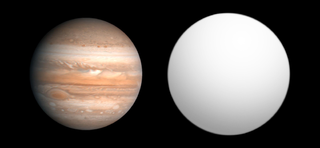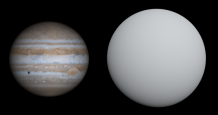Related Research Articles

WASP-13b, also known as Cruinlagh, is an extrasolar planet that was discovered in 2008 in the orbit of the sunlike star WASP-13. The planet has a mass of nearly half that of Jupiter, but a radius five-quarters of the size of Jupiter. This low relative mass might be caused by a core that is of low mass or that is not present at all.
WASP-13, also named Gloas, is a star in the Lynx constellation. The star is similar, in terms of metallicity and mass, to the Sun, although it is hotter and most likely older. The star was first observed in 1997, according to the SIMBAD database, and was targeted by SuperWASP after the star was observed by one of the SuperWASP telescopes beginning in 2006. Follow-up observations on the star led to the discovery of planet Cruinlagh in 2008; the discovery paper was published in 2009.

Kepler-10, formerly known as KOI-72, is a Sun-like star in the constellation of Draco that lies 607 light-years from Earth. Kepler-10 was targeted by NASA's Kepler space telescope, as it was seen as the first star identified by the Kepler mission that could be a possible host to a small, transiting exoplanet. The star is slightly less massive, slightly larger, and slightly cooler than the Sun; at an estimated 11.9 billion years in age, Kepler-10 is 2.3 times the age of the Sun.

Kepler-20f (also known by its Kepler Object of Interest designation KOI-070.05) is an exoplanet orbiting the Sun-like star Kepler-20, the second outermost of five such planets discovered by NASA's Kepler spacecraft. It is located approximately 929 light-years (285 parsecs, or about 8.988×1015 km) from Earth in the constellation Lyra. The exoplanet was found by using the transit method, in which the dimming effect that a planet causes as it crosses in front of its star is measured. The planet is notable as it has the closest radius to Earth known so far.

K2-33b is a very young super-Neptune exoplanet, orbiting the pre-main-sequence star K2-33. It was discovered by NASA's Kepler space telescope on its "Second Light" mission. It is located about 453 light-years away from Earth in the constellation of Scorpius. The exoplanet was found by using the transit method, in which the dimming effect that a planet causes as it crosses in front of its star is measured.
CoRoT-21b is a transiting exoplanet reportedly found by the CoRoT space telescope in 2011. Planetary parameters were published in 2012.

CoRoT-11b is a transiting Hot Jupiter-sized exoplanet found by the CoRoT space telescope in 2010. From obtained light curves and Bayesian inference on the data, it is highly likely that CoRoT-11b has been observed in a secondary eclipse around its host star.

CoRoT-12b is a transiting Hot Jupiter-sized exoplanet found by the CoRoT space telescope in 2010.

CoRoT-14b is a transiting Hot Jupiter exoplanet found by the CoRoT space telescope in 2010.

CoRoT-16b is a transiting exoplanet orbiting the G or K type main sequence star CoRoT-16 2,433 light years away in the southern constellation Scutum. The planet was discovered in June 2011 by the French-led CoRoT mission. CoRoT-16b was detected using the transit method, which measures the brightness changes during an eclipse. However, this planet has an eccentric orbit, which is unusual due to CoRoT-16b's proximity to its parent star and the age.
CoRoT-18b is a transiting hot Jupiter exoplanet found by the CoRoT space telescope in 2011. It orbits CoRoT-18 in the constellation of Monoceros. It is a G9V star with an effective temperature of 5,440 K, a mass of 0.95 M☉, a radius of 1.00 R☉, and a near-solar metallicity. Its age is unknown. A 2021 study utilizing the Rossiter–McLaughlin effect has determined the planetary orbit is probably aligned with the rotational axis of the star, with a misalignment equal to -10±20°.
CoRoT-19b is a transiting exoplanet found by the CoRoT space telescope in 2011.
CoRoT-20b is a transiting exoplanet found by the CoRoT space telescope in 2011.
CoRoT-22b is a transiting exoplanet smaller than Uranus found by the CoRoT space telescope in 2011 and confirmed in 2014.
CoRoT-23b is a transiting Hot Jupiter exoplanet found by the CoRoT space telescope in 2011.
Planet-hosting stars are stars which host planets, therefore forming planetary systems. There are correlations between stars' characteristics and the characteristics of the planets that orbit them.
HATS-11b, also known as EPIC 216414930b, is a confirmed exoplanet, or exosolar planet, discovered in 2016 and has been described as similar to Jupiter. It orbits the star HATS-11.

Kepler-93b (KOI-69b) is a hot, dense transiting Super-Earth exoplanet located approximately 313 light-years away in the constellation of Lyra, orbiting the G-type star Kepler-93. Its discovery was announced in February 2014 by American astronomer Geoffrey Marcy and his team. In July 2014, its radius was determined with a mere 1.3% margin of error, the most precise measurement ever made for an exoplanet's radius at the time.

TOI-4138 b is a transiting exoplanet orbiting the G-type subgiant TOI-4138 1,674 light years away in the northern circumpolar constellation Ursa Minor.
CoRoT-27b is a gas giant exoplanet that orbits a G-type star. Its mass is 10.39 Jupiters, it takes 3.6 days to complete one orbit of its star, and is 0.0476 AU from its star. Its discovery was announced in 2014.
References
- 1 2 3 "Notes on CoRoT-13 b". Extrasolar Planets Encyclopaedia . Retrieved 20 November 2016.
- 1 2 Cabrera, J.; et al. (2010). "Transiting exoplanets from the CoRoT space mission XIII. CoRoT-13b: a dense hot Jupiter in transit around a star with solar metallicity and super-solar lithium content". Astronomy and Astrophysics. 522. A110. arXiv: 1007.5481 . Bibcode:2010A&A...522A.110C. doi:10.1051/0004-6361/201015154.